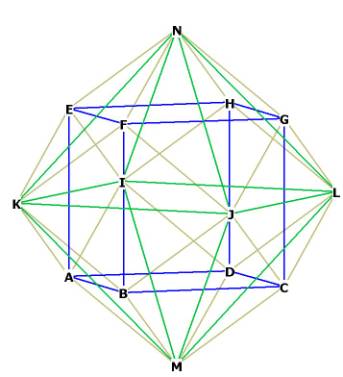|
(2019
midterm assignment) Model Midterm answers 2019 (Index) Essay 1: Compare, contrast, and evaluate Narratives of the Future |
 |
Ruth Brown
28 March 2019
The
Paths of the Future
When I began this course, I had no idea what to expect or how we would study
literature of the future. I am very inexperienced with the genre of science or
speculative fiction and usually avoid dystopian stories. I shouldn’t
have been surprised that a major theme is time and structure, but I was. I found
it interesting to learn that the course would be primarily divided into three
narratives of the future, creation/apocalypse, evolution, and alternative.
The first narrative introduced was creation/apocalypse and I found this pretty
clear to understand, especially in the context of reading texts like
Genesis and
Revelation. This narrative has a linear path of beginning, middle, end and
might be more easy for the human brain to comprehend. There is also a focus on
human relationships, such as families or communities and a clear distinction
between good and evil. In Genesis, we are presented with the creation of
the world, then scripture proceeds to follow human history, and then
Revelation gives a vision for the end of the world. It is a linear path and
it follows a chosen people as they learn to resist evil and prepare themselves
for the end of time.
Parable of the Sower
picks up this linear narrative and mirrors scriptural events. I didn’t realize
how similar they were until reading Laura Wilson’s essay where she points out
that Lauren begins the story in a community that is a utopia compared to the
world outside of it, but she is then forced out and must face trials outside of
it before beginning a new “utopian-esque”
community. In this text, Lauren is the “chosen one” trying to bring her message
to people and start a new community to face what seems like the end of the
world. This linear timeline works well in literature as stories have a
beginning, middle, and end. People might also like this narrative because of the
human characters and the idea of a “chosen one” to root for.
In comparison, evolution is different from creation/apocalypse in that it is
presented on a much larger scale, is not so human focused, and is not linear,
but rather like a spiral with no set beginning or ending. There are lots of
interconnected parts and the purpose is progress.
“Bears Discover Fire” is a great example of how
unclear evolution can be at times. Just as the title suggests, bears discover
fire and start using it to keep warm now that they are not hibernating in the
winter. The bears seem calm and intelligent and there are even theories that
they had previously discovered fire, but had forgot due to their hibernation. In
this case, there is no clear beginning and there are questions of when bears
started evolving to this level, how long it has taken, and if they have evolved
in other ways.
The Time Machine
is another text that shows the immensity of the time scale in evolution
narratives. Although it never specifically mentions how far into the future the
time machine can actually travel, the majority of the story takes place in the
year Eight Hundred and Two Thousand Seven Hundred and One A.D. and then the time
traveler travels beyond that into deep future. Once further into the future, he
continues to jump by a thousand years or more and eventually describes his last
stop as more than thirty million years hence. This interaction with time is so
grand, as humans normally think in years or maybe hundreds of years, but not
thousands and millions of years. Besides the large time scale, The Time
Machine also deals with another characteristic of evolution narratives, the
decline of human form and societies. In the future, humans evolve into a species
more animal like and in the deep future there are no human forms, but instead,
giant animals and enormous landscapes and nature scenes.
While creation/apocalypse narratives are focused on communities and evolution
narratives are focused on progress, alternative future narratives are focused
more on choices and the individual. There seems to be limitless possibilities
and choices and there is room for other cultures and genders. As I learned in my
web highlights assignment, it can also be physical or psychological realities.
The story "Better Be Ready 'bout Half Past
Eight” is not focused on alternative timelines, but on an alternative future
where gender and sexuality are not restricted and there is room to see differing
personalities and points of view. It is a future in which the mind is not
hampered by what the body determines and individuals can create new futures
through the opening of their mind.
Besides the focus on choices and individuals, another characteristic of
alternative futures is their unique time scale. Instead of being linear or
cyclical, they resemble a branching tree or a maze with many paths to explore.
The branching time line is clearly seen in the story
"Mozart in Mirrorshades” and it shows how the past and
the future can interact together. While it may not be for morally right reasons
that the future is interacting with the past, it does show how people can make
decisions to create different pasts to benefit their future. This mixed time
scale enhances the theme of choices and the idea that there is not one “right”
future, but many coexisting together.
By learning about these three narratives in science fiction, I have a better
idea of what to look for in specific texts. It enables me to focus on smaller
details instead of having to spend all my focus on the larger picture of
structure. It has also given me a greater appreciation for the way writers work
within these narratives as I continue to see different approaches and styles.
Although I have addressed these narratives as having distinct characteristics
and features, I have also learned that there is more interaction between them
than I originally thought. What may appear to be strictly a creation/apocalypse
narrative at first glance, could actually contain various evolutionary qualities
or vice versa. Furthermore, alternative futures may also have an evolutionary
nature in the feeling of repetition of futures or it could have an apocalyptic
aspect of a branch breaking off the tree and ending. These narratives have
proved more complex and diverse as I have continued to learn about them.
 |
 |
 |
